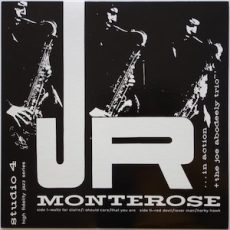
Requisites
Blowing In From Chicago ~ Cliff Jordan & John Gilmore | By Eddie Carter
As a youngster discovering this music, I was always captivated by jazz’s unique and spontaneous nature, particularly the ‘blowing session’ or ‘jam session.’ These impromptu performances, where musicians control the flow of musical ideas from moment to moment, are a testament to the music’s excitement and unpredictability. Whether in a live setting at a club, concert, or jazz festival or captured in a studio session, jazz’s enthusiasm, vitality, and freedom are always present.
This morning’s choice from my library is an excellent LP from 1957 by two tenor saxophonists who made significant impressions in jazz, Clifford Jordan and John Gilmore. Their only album as co-leaders is titled Blowing In From Chicago (Blue Note BLP 1549), which signifies their roots in the vibrant jazz scene of Chicago. The quintet has an excellent rhythm section consisting of Horace Silver on piano, Curly Russell on bass, and Art Blakey on drums. My copy is the 1983 Pathé Marconi-EMI French Mono reissue, sharing the original catalog number. Before I proceed, let me state that this is not a DMM (Digital Metal Mastering) pressing.
The album opener, Status Quo, is a lively tune by John Neely, with both horns leading the charge through the uptempo melody. John rips into the opening solo, aggressively slicing through each verse like a sharp blade. Clifford joins him next in a short exchange, then takes off with a supercharged reading. Horace shifts into high gear on the third statement with a blazing swiftness that’s equally inspired and scintillating. Art engages in a brief conversation with both horns, then brings the solos to a close with an electric performance illustrating his incomparable artistry before the ensemble returns to the theme and quick stop. The first of two originals by Jordan follows.
Bo-Till slows the tempo to a laid-back pace with a Latin flavor. After a short introduction by the trio, the quintet states the theme collectively, stepping aside for Jordan, who makes a profound impression with a beautifully conceived statement displaying a great tone throughout. Silver gets into the groove next with an incredible, smooth reading, one of his best on the album. Gilmore delivers the closing choruses of the song proficiently with meticulous execution. Blakey constructs a concise comment during the ensemble’s end theme and close.
Blue Lights by Gigi Gryce is a catchy tune that opens with the quintet laying down a gorgeous medium beat on the theme and gives everyone a solo opportunity. John steps into the spotlight with a spirited performance. Horace follows with notes of undeniable pleasure in one of his most robust solos. Clifford weaves his way through the next musical improvisation with astounding skill. Curly puts together a condensed reading that walks for one chorus with solid bass lines. Art breezes into a straightforward interpretation that culminates into a splendid summation of the first side.
The second side gets underway with Charlie Parker’s Billie’s Bounce, which gives everyone except Russell a lengthy solo canvas on which to work. Blakey begins with a high-voltage introduction that sets the pace for the following fiery quintet theme. Clifford packs a mighty punch on the opening statement with a fire-breathing showcase, preceding John, who exhibits a robust attack on the subsequent interpretation with extremely hot choruses. Horace takes over next for a scintillating performance, taking his piano on a sizzling uptempo ride. Both horns exchange a few riffs with Art before the drummer gives an unaccompanied propulsive exhibition into the ending theme.
Clifford’s second original is a blues titled Evil Eye, which eases the throttle back from the previous burner to a medium pace with a collective melody by the quintet. Jordan opens the solos with a series of choruses that are smooth and well-structured. In the following presentation, Gilmore shows that he can also interpret blues with plenty of soul, which develops nicely. Silver delivers a lightly swinging performance that expresses pleasure as he moves masterfully through each chorus. Both horns return to share a few more thoughts. Blakey makes a short statement preceding the theme’s reprise and finish.
The album’s final track is Everywhere, a mid-tempo original by Horace Silver, which I believe made its debut on this album. It opens with a simple opening melody by the ensemble in unison, and the solo order is Gilmore, Jordan, Silver, and Blakey. John takes the stage first with a bewitchingly delightful opening statement. Clifford makes his case with a captivating contribution that moves sprightly alongside the rhythm section’s groundwork drive. Horace takes over next, communicating his points well with a pronounced beat. Art puts the joyous exclamation point on the song and album with a compelling statement that leads the group back to the ending theme and close.
Clifford Jordan recorded three albums for Blue Note; the other two LPs are Cliff Jordan and Cliff Craft. He played and recorded with many elite jazz musicians, including Charles Mingus and Max Roach. Clifford also enjoyed success recording as a leader and sideman, and in my opinion, his discography is well worth investigating. He remained in demand over the next three decades and toured worldwide. His final album was a 1992 live recording at Condon’s in New York City for Milestone, where he performed with his big band, Down Through The Years. He lost his battle against lung cancer on March 27, 1993, at age sixty-one.
Blowing In From Chicago was the first of three appearances on Blue Note by John Gilmore. The other two were as a sideman on two of Andrew Hill’s LPs, Andrew and Compulsion. He began playing the clarinet at fourteen, then pursued a musical career after a four-year stint in the United States Air Force, where he took up and played the tenor saxophone. He began a forty-year term with Sun Ra in 1953 and recorded for various labels with his group, Sun Ra Arkestra. During this time, Gilmore also toured with The Jazz Messengers and recorded with Paul Bley, Andrew Hill, Pete LaRoca, McCoy Tyner, and Dizzy Reece. After Sun Ra’s death on May 30, 1993, Gilmore led the Arkestra for two years before his death from emphysema on August 20, 1995, at age sixty-three.
As for the music on Blowing In From Chicago, it’s fantastic, as are the solos on each track, and the sound quality of this reissue is exemplary. The instruments deliver an excellent soundstage throughout the treble, midrange, and bass that places your sweet spot in the studio with the musicians. It’s a cut above the average debut album and a title I recommend as a terrific addition to any jazzophile’s library, particularly if you’re a hard-bop fan or love a good “blowing session” or “jam session.”
~ Andrew (Blue Note BLP 4203/BST 84203), Cliff Jordan (Blue Note BLP 1565), Cliff Craft (Blue Note BLP 1582/BST 81582), Compulsion (Blue Note BLP 4217/BST 84217), Down Through The Years (Milestone MCD-9197-2) – Source: Discogs.com
~ Billie’s Bounce – Source: JazzStandards.com
~ John Gilmore, Andrew Hill, Clifford Jordan – Source: Wikipedia.org
© 2024 by Edward Thomas Carter
More Posts: choice,classic,collectible,collector,history,instrumental,jazz,music,saxophone

Jazz Poems
ALABAMA, c. 1963:
A BALLAD BY JOHN COLTRANEBut
Shouldn’t this state have a song?
Long, gliding figures of my breath
Of breath
Lost?
Somebody can’t sing
Because somebody’s gone
Somebody can’t sing
Because somebody’s gone.
Shouldn’t this landscape
Hold a true anthem
What
You can’t do?
Whom
You can’t invent?
Where
You can’t stay?
Why
You won’t keep it?
But
Shouldn’t this state
Have a song?
And shall we call it
My face will murder me?
And shall we call it
I’m not waiting?
CORNELIUS EADY
from Jazz Poems ~ Selected and Edited by Kevin Young
More Posts: book,classic,collectible,history,jazz,library,poet

Requisites
In Action ~ J.R. Monterose and The Joe Abodeely Trio | By Eddie Carter
My next record from the library up for discussion is a little-known but highly sought-after 1964 studio album by tenor saxophonist J.R. Monterose and The Joe Abodeely Trio. In Action (Studio 4 SS 100) was recorded during a ten-month engagement at Iowa’s only jazz club at the time, The Tender Trap, which Abodeely owned. This album, with its historical significance in Monterose’s discography, is a unique release. There were only two hundred fifty original LPs made; fans could only purchase them at the cloakroom of the Cedar Rapids Jazz Club, and an original Mint pressing would cost a collector four figures or more. He was born Frank Anthony Peter Vincent Monterose, Jr. and the initials J.R. come from Jr.
Monterose began playing the clarinet at age thirteen, then took up the tenor sax two years later after hearing tenor man Tex Beneke, who was a member of the Glenn Miller Orchestra. The trio consists of Dale Oehler on the piano, Gary Allen on bass, and Joe Abodeely on drums. My copy is the 1983 U.S. Mono reissue (V.S.O.P. Records V.S.O.P. #1), a small record label known for its high-quality reissues of jazz LPs from the fifties and sixties. Waltz For Claire is a very pretty tune by J.R., starting with a cheerful theme. He continues with a blissful opening statement by the saxophonist, who communicates his feelings about the young lady with a charming performance. Dale takes the listener on a relaxing joyride in the closing solo ahead of the theme’s restatement and close.
I Should Care by Alex Stordahl, Paul Weston and Sammy Cahn premiered in the 1945 film Thrill of a Romance. The quartet begins with Monterose’s sensual sound of his tenor sax, delivering a delicate melody and then handling each note of the opening statement with tender, loving care. Oehler follows with a passionate performance packed with plenty of feeling before J.R. repeats the theme. That You Are, Monterose’s next tune, is a creative reimagining of All The Things You Are, a popular jazz standard. Monterose builds on the changes of the original with an upbeat, bright, bouncy theme. J.R. puts his thoughts into expressive verses first. Dave provides the exclamation point in an energetic solo, leading to the ending theme and fadeout.
The tempo moves upward to kick off the second side with Red Devil by Monterose, beginning at a brisk beat for the quartet’s theme. The saxophonist leads off with a flawless opening solo, and then Oehler dazzles on the finale with an imaginative flair. Lover Man by Jimmy Davis, Roger Ramirez, and James Sherman begins with a pensive melody by the foursome, segueing to J.R.s intimately warm interpretation. Dave responds with a delicately elegant and beautiful presentation. Monterose closes with a few final comments of exquisite softness anchored by Gary and Joe’s subtle supplement ahead of the tender close.
The final track is Monterose’s Herky Hawks, an uptempo tune that deceptively starts with a two-instrument conversation between the saxophonist and pianist at a slow tempo. This musical dialogue sets the stage for the rest of the piece. The discussion gradually builds in intensity, leading to a swift-moving speedy theme. This tune is a scorcher from the start, and the saxophonist turns the heat way up in the first of two solos. Dave attacks the next reading with aggressive fierceness, and then J.R. ends the album with a blistering final performance preceding the climax.
The recording engineers on this reissue are Dimitri Sotirakis and Myron Schiebel. Although there’s no information on either engineer, their work speaks volumes. They’ve done an excellent job with the sound quality of this album, bringing out the richness and depth of the music. The excellent sonics throughout the treble, midrange and bass complement the inspired performances by J.R. Monterose and The Joe Abodeely Trio, making In Action an underrated release deserving a spot in your jazz library!
~ Lover Man – Source: JazzStandards.com
~ I Should Care – Source: Wikipedia.org
© 2024 by Edward Thomas Carter
More Posts: choice,classic,collectible,collector,history,instrumental,jazz,music,saxophone

Jazz Poems
FOUR BONGOS: TAKE THE A TRAIN for Vinnie
The drummer wears suspenders to look like an old-timer, and plays a salsa “Caravan,” bad boy from the panyard with an evil, evil beat. The conga man chants Yoruba and shakes his sweat loose on a girl up front. His hand worries the drum like a live fish trashing. Call the bassist “Pops,” with his grizzly goatee, his Banshee yelp, his rhumba step. The hall is fluorescent. “Take a Train,” Lawrence Welk called that tune, and played. Ellington hovers above this group like changeable weather, in gabardine. ELIZABETH ALEXANDERfrom Jazz Poems ~ Selected and Edited by Kevin Young
More Posts: book,classic,collectible,history,jazz,library,poet

Requisites
The Final Tour: Copenhagen, March 24, 1960 ~ Miles Davis and John Coltrane | By Eddie Carter
In this morning’s discussion, I’m presenting an album by Miles Davis and John Coltrane from the library for your consideration. The Miles Davis Quintet performed at the distinguished Denmark venue, Tivolis Koncertsal, for the first time as part of The Spring 1960 Jazz at The Philharmonic European Tour. However, changes were on the way, as the album’s title suggests, The Final Tour: Copenhagen, March 24, 1960 (Columbia Legacy 88985498741). It would mark the end of an era as tenor saxophonist John Coltrane was looking to leave and start his group. The rhythm section, Wynton Kelly on piano, Paul Chambers on bass, and Jimmy Cobb on drums, would also leave to become The Wynton Kelly Trio.
Despite the underlying questions facing the trumpeter, the quintet’s three performances for the capacity audience that evening were brilliant and a highlight of the tour. To kick things off, Norman Granz, the master of ceremonies, introduced each man individually, with the crowd’s largest ovations reserved for Paul, John, and Miles. My copy is the 2018 European Mono Limited Edition reissue. With a few snaps of the leader’s fingers, the trio kicks off So What by Miles Davis with a short introduction segueing into Miles’ and John’s infectious melody, a captivating tune that immediately draws you in. Davis ignites the first solo with intense heat. John comes in next to dispense a bit of rhythmic fury, and then Wynton infuses the finale with jubilant enthusiasm ahead of the closing chorus and climax.
The pace slows to mid-tempo as the ensemble begins On Green Dolphin Street by Bronislaw Kaper and Ned Washington from the 1947 film Green Dolphin Street. The first part of this standard opens with the theme unfolding at a leisurely pace and Miles, on the muted horn, leading the way into a delightful opening statement. John soars cheerfully into a captivating, well-behaved performance. Part Two of On Green Dolphin Street starts on the second side, with Wynton cruising at a comfortable speed behind both horns in the following interpretation, as smooth as silk. Paul takes his first opportunity to solo with a brisk footnote on the closing statement that swings masterfully into the theme’s return and finale.
All Blues by Miles Davis affords the leader, John, and Wynton ample solo space. Paul gets things off to a good start with a concise introduction, leading to Miles’s carefree theme back on the muted horn. He removes it to begin the opening statement. John follows him with a relaxing interpretation that is as enjoyable as a day at the beach. Wynton sustains the easygoing pace with a gorgeous performance into the ending theme and soft summation. The closer is an incomplete take of Miles’ The Theme, a deliberate choice that signals the end of the set and album, lasting only thirty seconds until it fades to nothingness. The mastering of The Final Tour: Copenhagen, March 24, 1960, by Mark Wilder is a demonstration class and a great way to show off a mid-level or high-end audio system.
The vinyl is exceptionally quiet until the music starts, and the instruments have outstanding detail. This reveals an incredible soundstage with superbly presented music, thanks to jazz producer George Wein, Danish Radio and the Danish Programming Company, who originally recorded the shows for broadcast. This is my first LP from the We Are Vinyl series from Columbia-Legacy, and judging by its superb sound quality, it won’t be the last. If you’re a fan of either of these giants and are looking for a live jazz album where each musician is at the peak of their creativity. In that case, I enthusiastically invite you to check out The Final Tour: Copenhagen, March 24, 1960, by Miles Davis and John Coltrane. It’s an LP that merits serious consideration for any jazz fan’s library, and I am sure you’ll enjoy it!
~ On Green Dolphin Street – Source: JazzStandards.com
© 2024 by Edward Thomas Carter
More Posts: choice,classic,collectible,collector,history,instrumental,jazz,music,saxophone,trumpet



